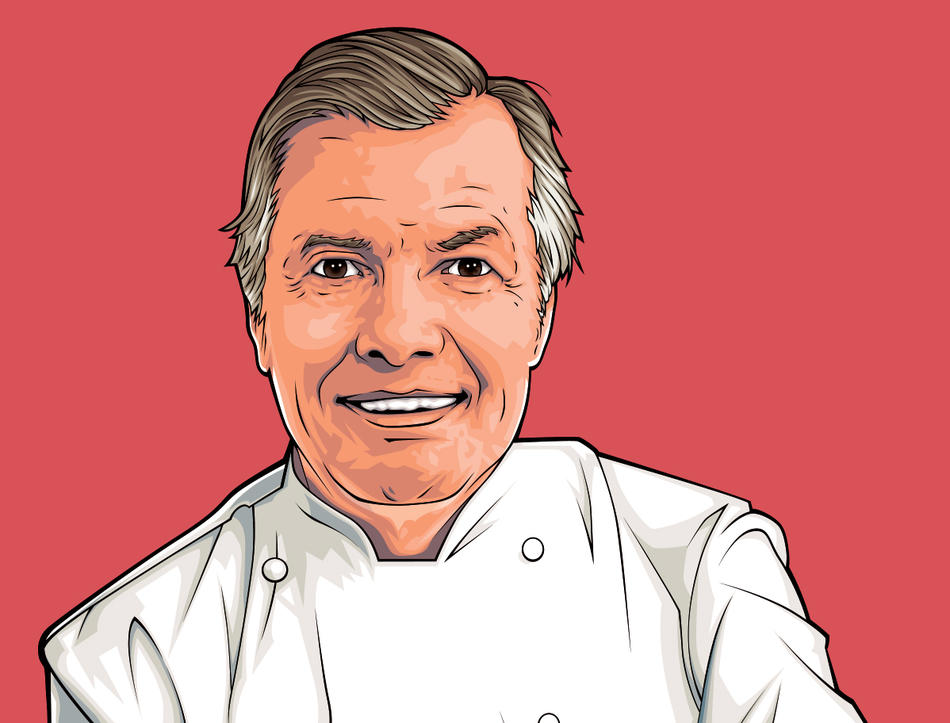You’re known for your illustrious culinary career, but you’re also a scholar of French literature. How did you end up at Columbia?
I came to America in September of 1959 to work at the famous French restaurant Le Pavillon. I hadn’t even graduated from high school — I had been working in restaurants since I was thirteen. But I always knew that I wanted to go back to school. I happened to travel across the Atlantic on a boat with a lot of exchange students, and one night on deck I struck up a conversation with a professor, who told me that Columbia was the best university in the city. I could barely speak English then, but I took the subway uptown and asked how I could apply. After two years of preparatory courses and entrance exams, I started at the School of General Studies.
Why did you decide to return to a career in the kitchen?
I never stopped cooking. I worked in restaurants for the entire time that I was studying. I even turned down a scholarship for graduate studies because it stipulated that I couldn’t work more than twenty hours a week. I did ultimately start a PhD program in literature, and I might have continued down that path, but Columbia rejected my thesis proposal.
What was the topic of your thesis?
It was about food, of course! The history of French food in the context of literature. My adviser — a Frenchman, no less — told me that it was too frivolous for serious academic pursuit. This was in the early 1970s; it was a different time. No one was thinking seriously about food then. Now there are entire degree programs at major universities in food studies. When Boston University was starting a culinary department, I helped to found their master’s program in gastronomy — an academic discipline that thinks about food in the context of literature, sociology, and history. When I was developing the curriculum, I knew exactly where to start my research — I picked up where I had left off on my thesis. I just had to wait for America to catch up a little bit.
America is clearly more interested in food now. But do you think the American palate has caught up, too? I noticed, for example, that your new cookbook includes a full chapter on offal, which is probably new to many home cooks.
When I first came to America, I remember going to a grocery store on 50th Street at First Avenue. I walked through the aisles looking for the produce section, and all they had was iceberg lettuce. When I asked where I could find mushrooms, they pointed me to the canned goods. The change over the last few decades has been astounding. America is absolutely in a food revolution — from wine producers in California to artisanal cheesemakers and bakers — and people’s tastes are changing all the time. I notice that young chefs are increasingly interested in sweetbreads and other kinds of organ meats. Those were things that I grew up cooking and eating in France. They’re never going to be for everyone, especially if you’re not used to the taste, but I do finally feel that some of my readers are ready to try working with these kinds of ingredients.
This will be your twenty-sixth cookbook, a companion to your thirteenth PBS television series. What do you think makes this collection distinct?
I’ve written a lot of books that have had very specific goals. I wrote a book on budget shopping and cooking, for example, and one for the Cleveland Clinic on heart-healthy cooking. I’ve always thought of myself as a teacher first, and it’s been a pleasure to help people solve the problems that they encounter in the kitchen. But at this later stage in my career, I wanted to do something more personal. I’ve been married for fifty years, and every time my wife and I have hosted a dinner together, I’ve drawn up a menu of what we’re serving. I add some pictures — decorative drawings or paintings of the food — and have the guests sign the back, and then I put it into a binder. We now have eight or nine of those binders, and it’s wonderful to go back and remember the food and the company. Those are the recipes in this book.
Is that where the art in the book comes from?
Yes, that’s all mine, and I’m afraid you can blame that on Columbia, too. I took two drawing classes as electives and found that I loved it. I suppose if cooking didn’t work out and academia didn’t work out, I could have always been a painter ...



